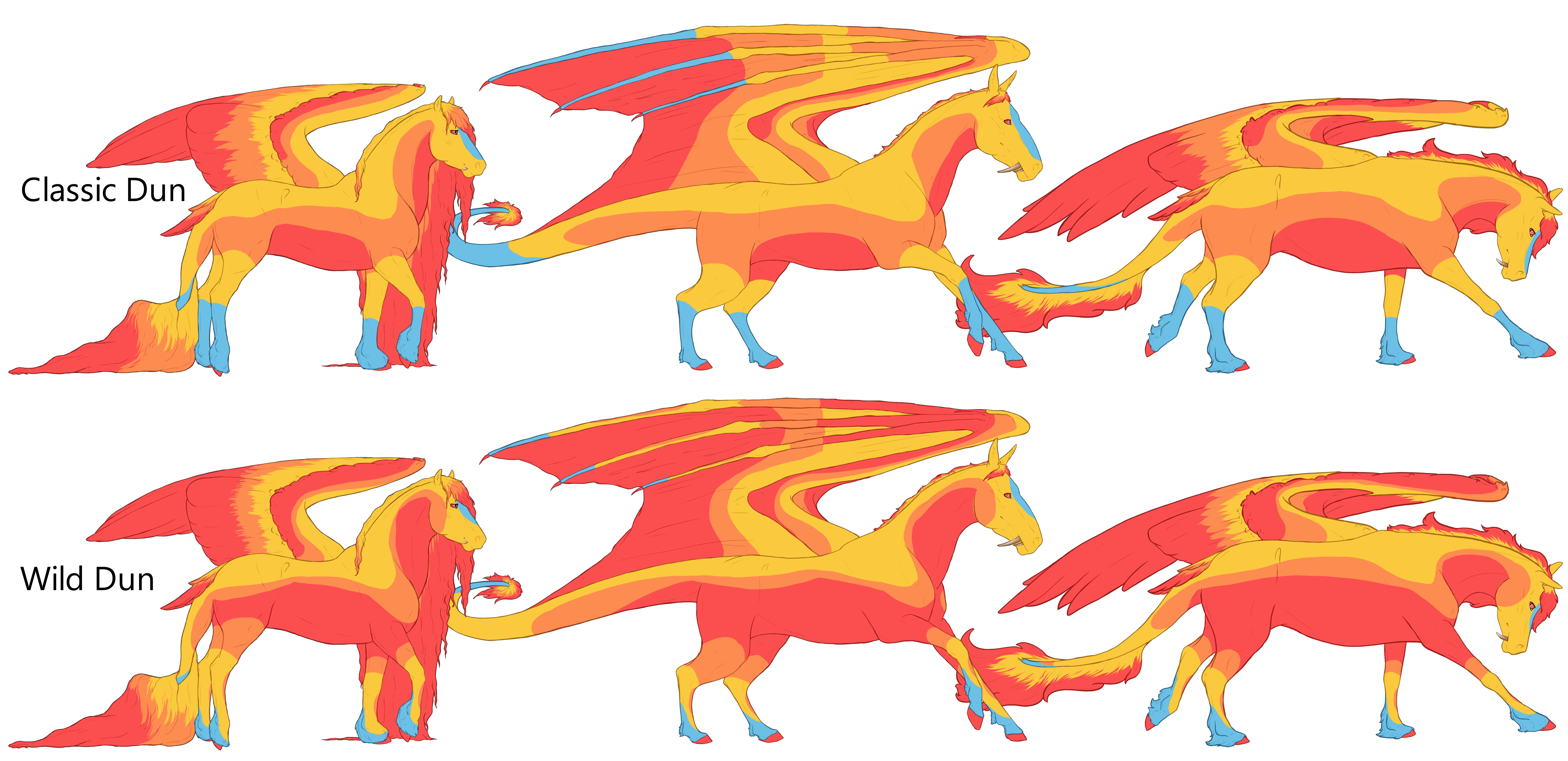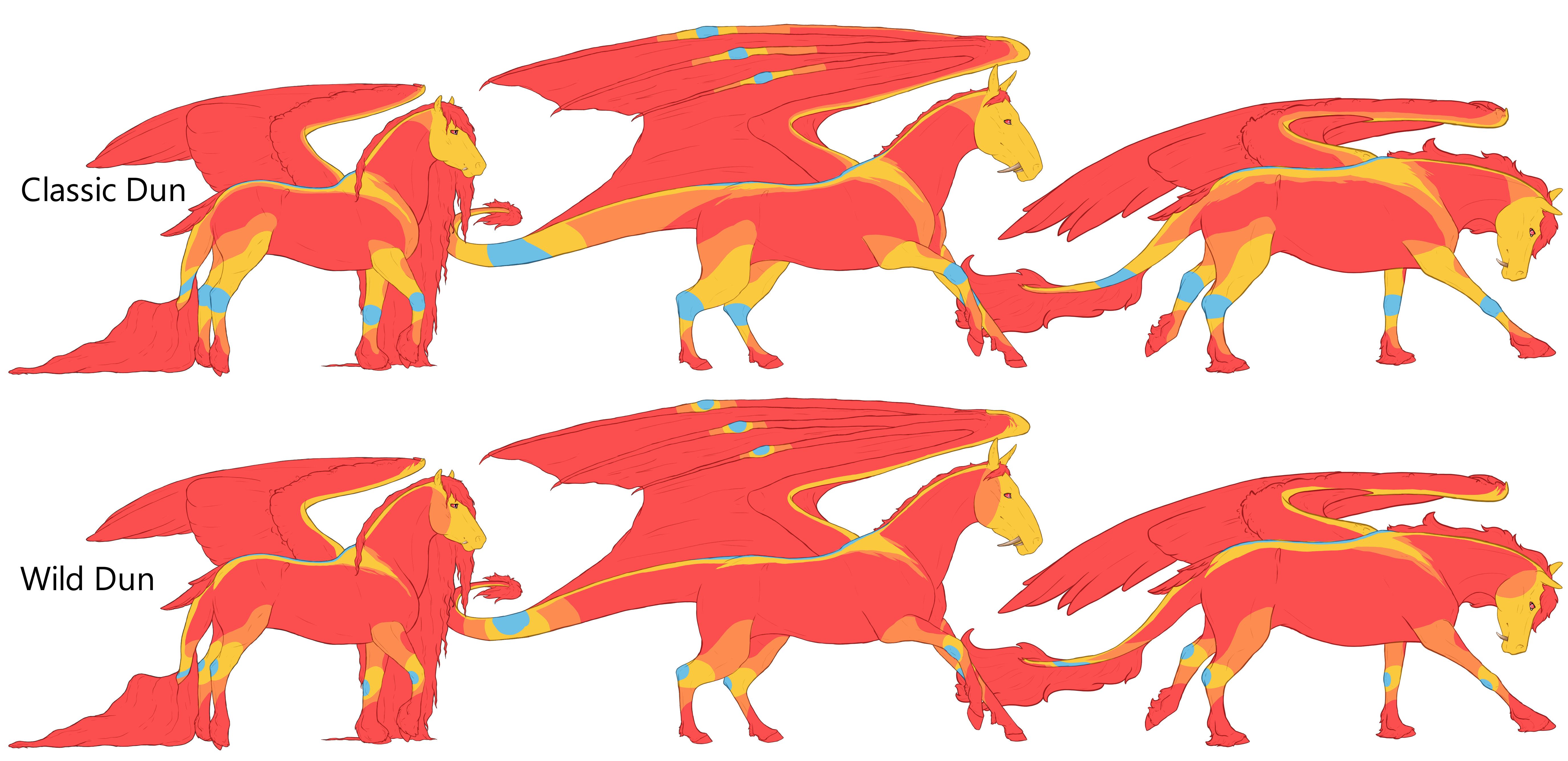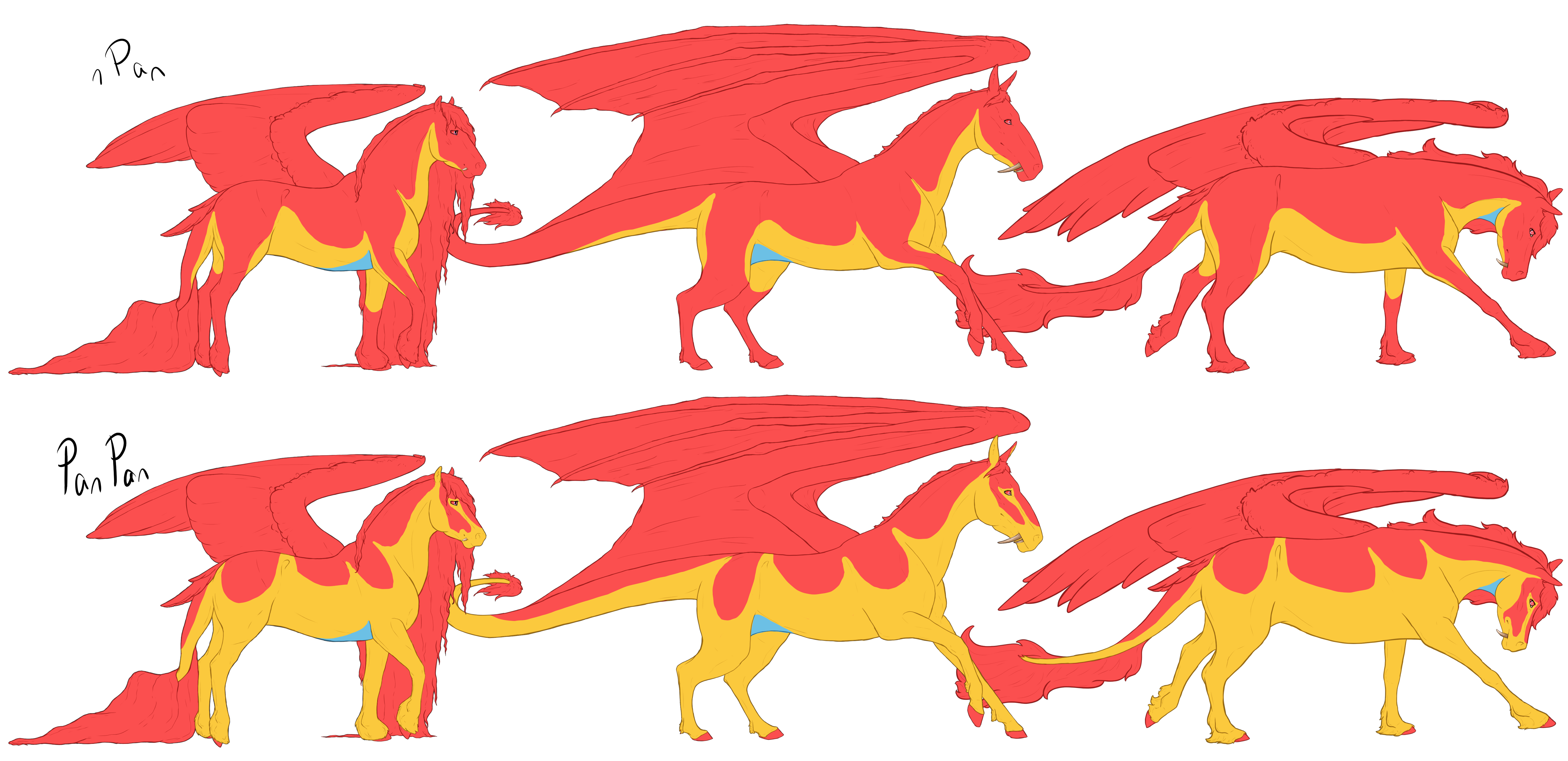Traits
Dun[E A D] (Common)
Dun
Bay[E A] + Dun[D]
Trait Count - 1
Genetic Code Variations
nD | DD
Dun lightens the coat overall but leaves darker points and primitive markings. Minimum required points and markings are; dorsal stripe, leg barring, leg points, and a facial mask. Optional maximum points and markings are; cobwebbing(facial barring), shoulder barring, barbed dorsal stripe, extreme leg barring, and frosting[lightened guard hairs at the base of the mane and tail].
- Skin color is unaffected by dun.
- Flight feathers and webbing will match mane color.
- Hoof color tends to be slightly darker than the skin color.
Eye Colors
Orange, Amber, Yellow
Point Range
Blue is the minimum required expression.
Yellow is the maximum optional expression.
Orange is the optional max range for DD duns.
Red is the area expression is not allowed.
Barring Range
Palette
Classic Champagne[E Ch] (Common)
Classic Champagne
Black[E] + Champagne[Ch]
Trait Count - 1
Genetic Code Variations
nCh | ChCh
Champagne dilutes the coat, makes the skin molted, and turns the eyes green in color.
Retain dark mane.
- All base coats will have lighter mottled skin.
- Flight feathers and webbing will match mane color.
- Hoof color tends to be slightly darker than the skin color.
- Optionally can add a shine to the coat. Shine will be less obvious than a pearl shine.
The optional shine that champagne can have will affect all markings on the body and the mane but will go under all BA mutation markings on the wings and in the mane. All physical mutations will be unaffected as well.
Optional shine will not affect the following body markings; Crystal, Felis, Festive, Marrow, Shadow, Steam Powered, Voodoo
Eye Colors
Green, Hazel
Palette
Gold Champagne[ee Ch] (Common)
Gold Champagne
Chestnut[ee] + Champagne[Ch]
Trait Count - 1
Genetic Code Variations
nCh | ChCh
Champagne dilutes the coat, makes the skin molted, and turns the eyes green in color.
Will have lighter manes.
- All base coats will have lighter mottled skin.
- Flight feathers and webbing will match mane color.
- Hoof color tends to be slightly darker than the skin color.
- Optionally can add a shine to the coat. Shine will be less obvious than a pearl shine.
The optional shine that champagne can have will affect all markings on the body and the mane but will go under all BA mutation markings on the wings and in the mane. All physical mutations will be unaffected as well.
Optional shine will not affect the following body markings; Crystal, Felis, Festive, Marrow, Shadow, Steam Powered, Voodoo
Eye Colors
Green, Hazel
Palette
Champagne[Ch] (Common)
nCh | ChCh
Trait Count - 1
Champagne dilutes the coat, makes the skin molted, and turns the eyes green in color.
Black and Bay variants will have a dark mane. Chestnut will have lighter manes.
- All base coats will have lighter mottled skin.
- Flight feathers and webbing will match mane color.
- Hoof color tends to be slightly darker than the skin color.
- Optionally can add a shine to the coat. Shine will be less obvious than a pearl shine.
The optional shine that champagne can have will affect all markings on the body and the mane but will go under all BA mutation markings on the wings and in the mane. All physical mutations will be unaffected as well.
Optional shine will not affect the following body markings; Crystal, Felis, Festive, Marrow, Shadow, Steam Powered, Voodoo
Eye Colors
Green, Hazel
Classic Champagne - Black with nCh or ChCh
Amber Champagne - Classic Bay with nCh or ChCh
Wild Amber Champagne - Wild Bay with nCh or ChCh
Sable Champagne - Seal Bay with nCh or ChCh
Middle palette is for chrome.
Gold Champagne - Chestnut with nCh or ChCh
Dun[D] (Common)
nD | DD
Trait Count - 1
Dun lightens the coat overall but leaves darker points and primitive markings. Minimum required points and markings are; dorsal stripe, leg barring, leg points, and a facial mask. Optional maximum points and markings are; cobwebbing(facial barring), shoulder barring, barbed dorsal stripe, extreme leg barring, and frosting(lightened guard hairs at the base of the mane and tail).
- Skin color is unaffected by dun.
- Flight feathers and webbing will match mane color.
- Hoof color tends to be slightly darker than the skin color.
Eye Colors
Orange, Amber, Yellow
Point Range
Blue is the minimum required expression.
Yellow is the maximum optional expression.
Orange is the optional max range for DD duns.
Red is the area expression is not allowed.
Barring Range
Grulla - Black with nD or DD
Dun - Classic Bay with nD or DD
Wild Dun - Wild Bay with nD or DD
Brown Dun - Seal Bay with nD or DD
Middle palette is for chrome.
Red Dun - Chestnut with nD or DD
Wild Amber Champagne[E A+ Ch] (Common)
Wild Amber Champagne
Wild Bay[E A+] + Champagne[Ch]
Trait Count - 1
Genetic Code Variations
nCh | ChCh
Champagne dilutes the coat, makes the skin molted, and turns the eyes green in color.
Retain dark mane.
- All base coats will have lighter mottled skin.
- Flight feathers and webbing will match mane color.
- Hoof color tends to be slightly darker than the skin color.
- Optionally can add a shine to the coat. Shine will be less obvious than a pearl shine.
The optional shine that champagne can have will affect all markings on the body and the mane but will go under all BA mutation markings on the wings and in the mane. All physical mutations will be unaffected as well.
Optional shine will not affect the following body markings; Crystal, Felis, Festive, Marrow, Shadow, Steam Powered, Voodoo
Eye Colors
Green, Hazel
Palette
Sable Champagne[E At Ch] (Common)
Sable Champagne
Seal Bay[E At] + Champagne[Ch]
Trait Count - 1
Genetic Code Variations
nCh | ChCh
Champagne dilutes the coat, makes the skin molted, and turns the eyes green in color.
Retain dark mane.
- All base coats will have lighter mottled skin.
- Flight feathers and webbing will match mane color.
- Hoof color tends to be slightly darker than the skin color.
- Optionally can add a shine to the coat. Shine will be less obvious than a pearl shine.
The optional shine that champagne can have will affect all markings on the body and the mane but will go under all BA mutation markings on the wings and in the mane. All physical mutations will be unaffected as well.
Optional shine will not affect the following body markings; Crystal, Felis, Festive, Marrow, Shadow, Steam Powered, Voodoo
Eye Colors
Green, Hazel
Palette
Middle palette is for chrome.
Grulla[E D] (Common)
Grulla
Black[E] + Dun[D]
Trait Count - 1
Genetic Code Variations
nD | DD
Dun lightens the coat overall but leaves darker points and primitive markings. Minimum required points and markings are; dorsal stripe, leg barring, leg points, and a facial mask. Optional maximum points and markings are; cobwebbing(facial barring), shoulder barring, barbed dorsal stripe, extreme leg barring, and frosting[lightened guard hairs at the base of the mane and tail].
- Skin color is unaffected by dun.
- Flight feathers and webbing will match mane color.
- Hoof color tends to be slightly darker than the skin color.
Eye Colors
Orange, Amber, Yellow
Point Range
Blue is the minimum required expression.
Yellow is the maximum optional expression.
Orange is the optional max range for DD duns.
Red is the area expression is not allowed.
Barring Range
Palette
Red Dun[ee D] (Common)
Red Dun
Chestnut[ee] + Dun[D]
Trait Count - 1
Genetic Code Variations
nD | DD
Dun lightens the coat overall but leaves darker points and primitive markings. Minimum required points and markings are; dorsal stripe, leg barring, leg points, and a facial mask. Optional maximum points and markings are; cobwebbing(facial barring), shoulder barring, barbed dorsal stripe, extreme leg barring, and frosting[lightened guard hairs at the base of the mane and tail].
- Skin color is unaffected by dun.
- Flight feathers and webbing will match mane color.
- Hoof color tends to be slightly darker than the skin color.
Eye Colors
Orange, Amber, Yellow
Point Range
Blue is the minimum required expression.
Yellow is the maximum optional expression.
Orange is the optional max range for DD duns.
Red is the area expression is not allowed.
Barring Range
Palette
Brown Dun[E At D] (Common)
Brown Dun
Seal Bay[E At] + Dun[D]
Trait Count - 1
Genetic Code Variations
nD | DD
Dun lightens the coat overall but leaves darker points and primitive markings. Minimum required points and markings are; dorsal stripe, leg barring, leg points, and a facial mask. Optional maximum points and markings are; cobwebbing(facial barring), shoulder barring, barbed dorsal stripe, extreme leg barring, and frosting[lightened guard hairs at the base of the mane and tail].
- Skin color is unaffected by dun.
- Flight feathers and webbing will match mane color.
- Hoof color tends to be slightly darker than the skin color.
Eye Colors
Orange, Amber, Yellow
Point Range
Blue is the minimum required expression.
Yellow is the maximum optional expression.
Orange is the optional max range for DD duns.
Red is the area expression is not allowed.
Barring Range
Palette
Middle palette is for chrome.
Wild Dun[E A+ D] (Common)
Wild Dun
Wild Bay[E A+] + Dun[D]
Trait Count - 1
Genetic Code Variations
nD | DD
Dun lightens the coat overall but leaves darker points and primitive markings. Minimum required points and markings are; dorsal stripe, leg barring, leg points, and a facial mask. Optional maximum points and markings are; cobwebbing(facial barring), shoulder barring, barbed dorsal stripe, extreme leg barring, and frosting[lightened guard hairs at the base of the mane and tail].
- Skin color is unaffected by dun.
- Flight feathers and webbing will match mane color.
- Hoof color tends to be slightly darker than the skin color.
Eye Colors
Orange, Amber, Yellow
Point Range
Blue is the minimum required expression.
Yellow is the maximum optional expression.
Orange is the optional max range for DD duns.
Red is the area expression is not allowed.
Barring Range
Palette
Amber Champagne[E A Ch] (Common)
Amber Champagne
Bay[E A] + Champagne[Ch]
Trait Count - 1
Genetic Code Variations
nCh | ChCh
Champagne dilutes the coat, makes the skin molted, and turns the eyes green in color.
Retain dark mane.
- All base coats will have lighter mottled skin.
- Flight feathers and webbing will match mane color.
- Hoof color tends to be slightly darker than the skin color.
- Optionally can add a shine to the coat. Shine will be less obvious than a pearl shine.
The optional shine that champagne can have will affect all markings on the body and the mane but will go under all BA mutation markings on the wings and in the mane. All physical mutations will be unaffected as well.
Optional shine will not affect the following body markings; Crystal, Felis, Festive, Marrow, Shadow, Steam Powered, Voodoo
Eye Colors
Green, Hazel
Palette
Pangare[Pan] (Common)
Pangare || nPan | PanPan
Trait Count - 1
Pangare is a modifier that causes the underside, or belly, of a Beatus, to be lighter in color and even more saturated in color. Dominant pangare has a different expression than the non-dominant expression of pangare, this difference is most easily seen in the effect it has on Black-based BAs.
- Heavy pangare expressions need to have some kind of two-tone pangare present, this can be as simple as adding a lighter gradient by the hooves.
- Pangare will always be a soft gradient.
As stated above, pangare on black has a unique expression. In its non-dom form[nPan] will act relatively normal, lightening the undercoat. In its dominant form[PanPan], pangare will act as it does on bay and chestnut base BAs. This means PanPan on black will always be red hairs instead of lighter hairs like in nPan expressions.
Pan Range
Blue is the minimum required expression.
Yellow is the maximum optional expression.
Red is the area expression is not allowed.
Minimum Pangare Expression
The palettes provided are a simple guide, as different coats will likely have different variations. These guides do show an approximate as to how saturated pangare can be across different coat colors.
Medium PanPan and Maximum nPan Expression
Maximum PanPan Expression
The Demon is displaying PanPan on Black, which is why it's now red in color. The palettes on the min example will come in handy if you're struggling to get a nice color.



















